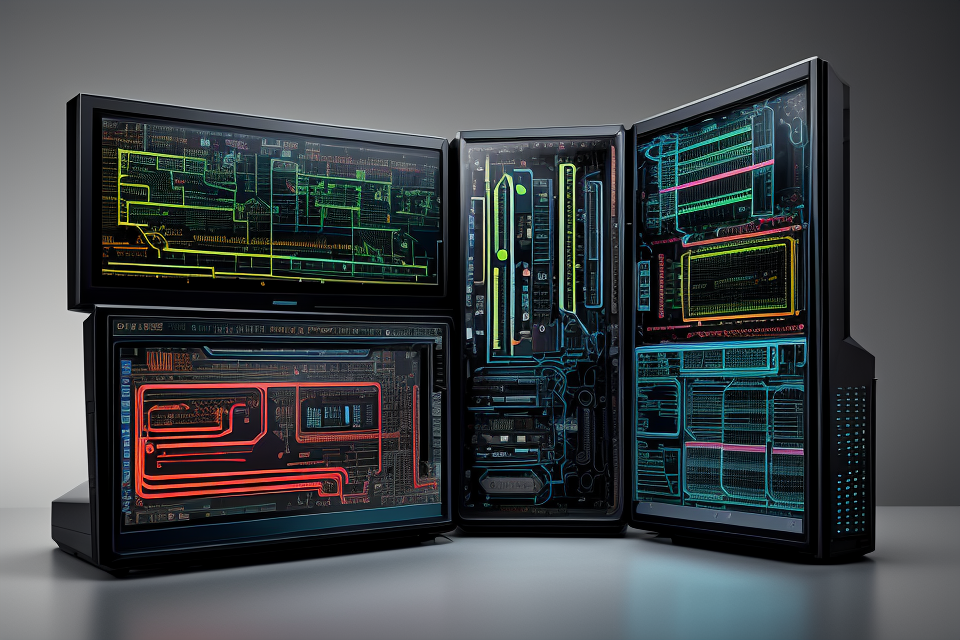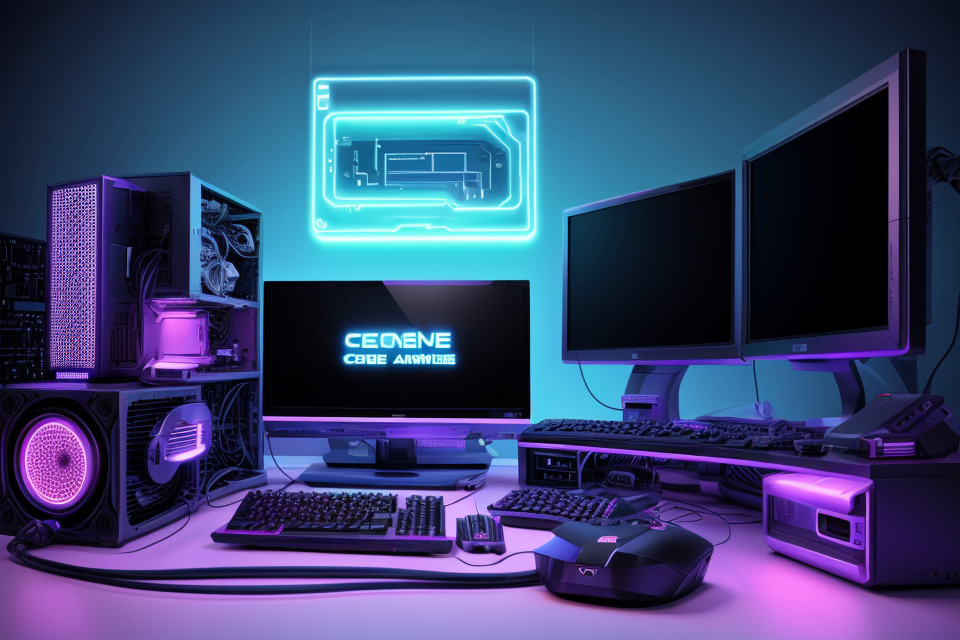In today’s world, it’s common to see devices that have both hardware and software components. But what exactly makes a device hardware or software? Is it the physical components that make it hardware or the programming that makes it software? This is a question that has puzzled many people, and in this article, we will explore the answer.
Hardware refers to the physical components of a device, such as the processor, memory, and storage. These components are designed to perform specific tasks and work together to make the device function. On the other hand, software refers to the programming that controls the device and makes it capable of performing tasks. This includes operating systems, applications, and other software programs.
In modern devices, hardware and software are closely integrated, and it can be difficult to distinguish between the two. However, understanding the difference between hardware and software is important for understanding how devices work and how they can be fixed or upgraded. In this article, we will delve into the details of what makes a device hardware or software and explore the ways in which they interact with each other. So, whether you’re a tech enthusiast or just curious about how devices work, read on to find out more!
A device can be considered hardware if it is a physical object that can be touched and is used to perform a specific function. Examples of hardware devices include computers, smartphones, and cameras. On the other hand, a device can be considered software if it is a program or set of instructions that run on a computer or other device. Examples of software devices include operating systems, applications, and games. In general, hardware devices are physical objects that can be touched and are used to perform a specific function, while software devices are programs or sets of instructions that run on a computer or other device.
Definition of Hardware and Software
Hardware
Hardware refers to the physical components of a device that are responsible for its operation. These components include circuits, chips, and electronic devices that work together to perform various functions. In simple terms, hardware is the tangible part of a device that can be seen and touched.
Hardware interacts with the user through input/output devices. Input devices allow the user to provide instructions to the device, while output devices display the results of the device’s operations. Examples of input devices include keyboards, mice, and touchscreens, while examples of output devices include monitors, speakers, and printers.
Hardware is essential to the operation of a device, as it provides the necessary components for processing and executing instructions. Without hardware, software would not be able to function, as it requires a physical device to run on. Therefore, hardware and software are intrinsically linked and cannot exist without each other.
Software
Software is a collection of programs and applications that run on a device, which control the hardware and perform various tasks. It is a critical component of any device, ranging from smartphones to personal computers, and it plays a vital role in the functionality of the device.
Types of Software
There are different types of software, including:
- System software: This is the software that manages the computer hardware and provides a platform for other software to run on. Examples of system software include operating systems, device drivers, and firmware.
- Application software: This is the software that performs specific tasks for the user. Examples of application software include word processors, spreadsheets, and video games.
- Programming software: This is the software that developers use to create other software. Examples of programming software include integrated development environments (IDEs) and compilers.
Operating Systems
An operating system (OS) is the most important type of system software. It is the software that manages the computer hardware and provides a platform for other software to run on. The OS is responsible for managing the computer’s memory, processing, and all of its software and hardware. It also provides a user interface that allows users to interact with the computer and run applications.
Some examples of popular operating systems include:
- Microsoft Windows
- Apple macOS
- Google Chrome OS
- Linux
Productivity Software
Productivity software is a type of application software that helps users to complete tasks more efficiently. It includes a wide range of programs, such as word processors, spreadsheets, and presentation software. These programs are designed to make it easier for users to create and manage documents, spreadsheets, and presentations.
Some examples of popular productivity software include:
- Microsoft Office
- Google Docs
- Apple Pages
- G Suite
Games
Games are a type of application software that are designed to provide entertainment and challenge players. They can be played on a variety of devices, including computers, consoles, and mobile devices. There are many different types of games, including action games, adventure games, puzzle games, and strategy games.
Some examples of popular game software include:
- Minecraft
- Fortnite
- Grand Theft Auto V
- The Legend of Zelda: Breath of the Wild
Differences Between Hardware and Software
Physical vs. Non-Physical
When it comes to differentiating between hardware and software, one of the most significant factors to consider is whether the device is physical or non-physical.
Hardware refers to any device or component that is tangible and can be physically touched. This includes items such as computers, smartphones, printers, and other electronic devices. Hardware components are typically made up of various parts, including circuits, processors, memory chips, and other electronic components. These parts work together to perform specific functions and provide users with a range of capabilities.
On the other hand, software is non-physical and exists as code. This includes programs, applications, and operating systems that are stored electronically and run on hardware devices. Software is typically created using programming languages and is designed to perform specific tasks or functions. It can be installed on hardware devices or accessed online through cloud-based services.
One of the key differences between hardware and software is that hardware is physical and tangible, while software is non-physical and exists as code. This means that hardware devices can be touched, felt, and seen, while software is intangible and exists only in electronic form. Additionally, hardware devices are typically designed to perform specific functions, while software is designed to provide users with a range of capabilities and functions.
Overall, understanding the differences between hardware and software is essential for anyone working in the technology industry or using technology in their daily lives. By understanding the physical vs. non-physical nature of these devices, users can make informed decisions about which devices to use and how to use them effectively.
Purpose
When it comes to understanding the differences between hardware and software, it is essential to consider their respective purposes. Hardware is designed to be used by the user, while software is designed to help the user accomplish tasks.
Hardware refers to the physical components of a device, such as the processor, memory, and storage. These components are responsible for the device’s functionality and are typically manufactured by companies specializing in electronic components. The primary purpose of hardware is to provide a platform for software to run on.
On the other hand, software refers to the programs and applications that run on a device. These can include operating systems, productivity suites, games, and other applications. Software is designed to help users accomplish specific tasks, such as creating documents, browsing the internet, or playing games.
While hardware and software are both essential components of a device, they serve different purposes. Hardware provides the physical platform for software to run on, while software provides the functionality and capabilities that make a device useful to the user. Understanding these differences is crucial for designing and developing effective devices and applications.
Development Process
Hardware development and software development are two distinct processes with different approaches and methodologies. The development process for hardware and software varies due to the nature of the products and the skills required to create them.
Hardware development is the process of designing and building physical components. It involves the creation of tangible objects that can be touched and seen. This process typically involves several stages, including research, design, prototyping, testing, and manufacturing. Hardware development requires expertise in materials science, mechanical engineering, electrical engineering, and manufacturing processes. The goal of hardware development is to create a product that meets the specifications and requirements of the user.
On the other hand, software development is the process of writing and testing code. It involves creating software programs that can run on computers, mobile devices, and other electronic devices. Software development typically involves several stages, including research, design, coding, testing, and deployment. Software development requires expertise in programming languages, software engineering, and user experience design. The goal of software development is to create a product that meets the needs of the user and is functional, efficient, and easy to use.
In summary, hardware development is the process of creating physical components, while software development is the process of creating software programs. Both processes require different skills and expertise and have different goals. The development process for hardware and software is critical to the success of the final product and must be carefully planned and executed to ensure that the product meets the needs of the user.
Examples of Hardware and Software
Hardware
- Smartphone: A smartphone is a portable electronic device that combines the features of a telephone with those of a computer. It is a hardware device that can make phone calls, send and receive text messages, and access the internet. A smartphone typically has a touch screen display, a camera, and various sensors, such as a gyroscope and accelerometer.
- Laptop: A laptop is a portable computer that is designed to be used on the go. It is a hardware device that can be used for a variety of tasks, such as writing documents, browsing the web, and playing games. A laptop typically has a keyboard, a touchpad, and a display screen.
- Printer: A printer is a hardware device that is used to produce printed documents. It can be connected to a computer or a mobile device and can print text, images, and other graphics. A printer typically has a print head, which is responsible for applying ink or toner to the paper.
Software
- Microsoft Word: Microsoft Word is a word processing software that is used to create and edit text documents. It is a software program that allows users to type, format, and save text documents. Microsoft Word is available for Windows and Mac computers, and it is part of the Microsoft Office suite of applications.
- Adobe Photoshop: Adobe Photoshop is a software program that is used to edit and manipulate digital images. It is a software program that allows users to crop, resize, and adjust the color and brightness of images. Adobe Photoshop is available for Windows and Mac computers, and it is part of the Adobe Creative Cloud suite of applications.
- Minecraft: Minecraft is a software game that is played on computers and mobile devices. It is a software program that allows players to build and explore virtual worlds. Minecraft is available for Windows, Mac, and mobile devices, and it has become one of the most popular video games of all time.
Determining if a Device is Hardware or Software
Factors to Consider
Physical components vs. non-physical components
One of the primary factors to consider when determining whether a device is hardware or software is the presence of physical components. Hardware devices are typically composed of physical components, such as circuits, chips, and other tangible materials. In contrast, software devices are intangible and exist only in digital form. For example, a computer is a hardware device that consists of physical components such as a CPU, motherboard, and hard drive, while software such as Microsoft Word is a non-physical entity that exists only in the form of code.
Purpose of the device
Another factor to consider when determining whether a device is hardware or software is its intended purpose. Hardware devices are typically designed to perform specific physical tasks, such as processing data or controlling mechanical movements. Software devices, on the other hand, are designed to perform logical or computational tasks, such as performing calculations or managing data. For example, a smartphone is a hardware device that is designed to make phone calls and send text messages, while an operating system such as Windows is a software program that manages the hardware components of a computer.
Development process
The development process is another important factor to consider when determining whether a device is hardware or software. Hardware devices are typically developed through a process of physical prototyping and testing, while software devices are developed through a process of coding and debugging. Additionally, hardware devices are typically manufactured and sold as physical products, while software devices are distributed and sold as digital products. For example, a car is a hardware device that is developed through a process of physical prototyping and testing, while a video game is a software program that is developed through a process of coding and debugging.
Examples of Devices
When trying to determine whether a device is hardware or software, it is essential to consider the device’s purpose and its physical form. In this section, we will provide examples of devices that are commonly classified as either hardware or software.
- Gaming console: A gaming console is a physical device designed for playing video games. It is a piece of hardware that is made up of electronic components, such as a processor, memory, and input/output ports. Examples of gaming consoles include PlayStation, Xbox, and Nintendo Switch.
- Fitness tracker: A fitness tracker is a wearable device that monitors a person’s physical activity, such as steps taken, heart rate, and sleep patterns. It is a hardware device that is typically worn on the wrist or attached to clothing. Examples of fitness trackers include Fitbit and Apple Watch.
-
Smartwatch: A smartwatch is a device that combines the functionality of a traditional watch with the features of a smartphone. It is a hardware device that can send and receive messages, make phone calls, and track fitness activities. Examples of smartwatches include Apple Watch and Samsung Galaxy Watch.
-
Operating system: An operating system is a software program that manages computer hardware and provides common services for computer programs. It is the foundational software that controls the computer’s hardware and enables other software programs to run. Examples of operating systems include Windows, macOS, and Linux.
- Social media platform: A social media platform is a software application that allows users to create and share content or connect with others online. Examples of social media platforms include Facebook, Twitter, and Instagram.
- E-commerce website: An e-commerce website is a software application that enables online shopping and sales. It is a software program that allows businesses to sell products and services online and provides a platform for customers to purchase them. Examples of e-commerce websites include Amazon and Etsy.
Importance of Identifying Hardware and Software
For Users
Identifying whether a device is hardware or software is crucial for users as it helps them understand the capabilities and limitations of the device. This knowledge enables users to make informed purchasing decisions and use the device effectively.
One of the main benefits of identifying hardware and software is that it allows users to determine the specific functions of a device. For instance, if a user knows that a device is hardware, they can expect it to have physical components such as buttons, ports, and screens. On the other hand, if a device is software, users can expect it to be intangible and exist only in digital form.
Furthermore, understanding whether a device is hardware or software can help users assess its durability and lifespan. Hardware devices typically have a longer lifespan than software devices, which can become outdated or obsolete with time. Therefore, users who know whether a device is hardware or software can make informed decisions about whether to invest in it for the long term.
In addition, identifying hardware and software can help users compare different devices and make informed decisions about which one to purchase. For example, if a user knows that a device is software, they can compare its features and functionality to other software programs available in the market. Similarly, if a user knows that a device is hardware, they can compare its physical components and build quality to other hardware devices.
Overall, identifying whether a device is hardware or software is crucial for users as it helps them understand the capabilities and limitations of the device, assess its durability and lifespan, and make informed purchasing decisions.
For Developers
Developers play a crucial role in creating software that is compatible with hardware. In order to do this, it is essential for developers to understand the difference between hardware and software. This knowledge enables them to design and develop software that is optimized for specific hardware.
Here are some of the ways in which identifying hardware and software helps developers:
- Hardware compatibility: Developers need to ensure that their software is compatible with the hardware of the device it is being installed on. For example, a software application designed for a smartphone with a certain processor and memory requirements may not work on a tablet with different hardware specifications. By understanding the differences in hardware specifications, developers can design software that is compatible with the device’s hardware.
- Performance optimization: By understanding the hardware specifications of a device, developers can optimize their software to take full advantage of the device’s capabilities. For instance, they can use specific hardware features, such as the camera or GPS, to enhance the functionality of their software. This can lead to better performance and a more seamless user experience.
- Debugging and troubleshooting: When a software application encounters problems, developers need to identify the root cause of the issue. If they do not understand the differences between hardware and software, they may waste time trying to fix issues that are actually caused by hardware problems. By understanding the hardware specifications of a device, developers can quickly identify and resolve hardware-related issues, saving time and resources.
- Testing and quality assurance: Developers need to test their software thoroughly to ensure that it works as intended. By understanding the hardware specifications of a device, they can create test cases that accurately simulate the device’s hardware. This helps to ensure that the software is thoroughly tested and of high quality.
In summary, identifying hardware and software is crucial for developers as it helps them design, develop, optimize, debug, troubleshoot, and test software applications. By understanding the differences between hardware and software, developers can create high-quality software that is compatible with a wide range of devices.
FAQs
1. What is hardware?
Hardware refers to the physical components of a device, such as the circuit boards, processors, memory chips, and other electronic components that make up the device. Hardware is tangible and can be touched, seen, and felt.
2. What is software?
Software refers to the programs and instructions that tell a device what to do. It includes operating systems, applications, and other programs that run on a device. Software is intangible and exists only in the form of code that can be run by a device’s hardware.
3. What is the difference between hardware and software?
The main difference between hardware and software is that hardware is the physical components of a device, while software is the programs and instructions that run on the device. Hardware is tangible and can be touched, seen, and felt, while software is intangible and exists only in the form of code that can be run by a device’s hardware.
4. Can a device have both hardware and software?
Yes, almost all devices have both hardware and software components. The hardware provides the physical structure and capabilities of the device, while the software provides the instructions and programs that make the device functional and useful.
5. Is hardware more important than software?
Both hardware and software are important for the functioning of a device. Without hardware, there would be nothing for the software to run on, and without software, the hardware would be useless. In many cases, the choice of hardware will be determined by the software that will run on it, and vice versa.



